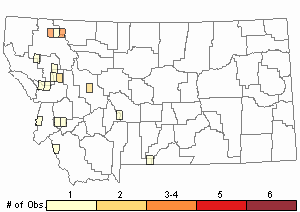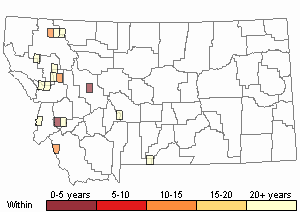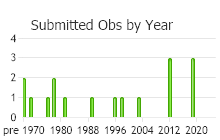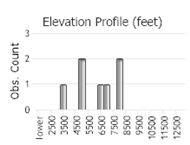View in other NatureServe Network Field Guides
NatureServe
Montana
Utah
Wyoming
Idaho
Wisconsin
British Columbia
South Carolina
Yukon
California
New York
Great Goldilocks - Polytrichum commune
Other Names:
Common Haircap Moss
General Description
Plants: Acrocarpous (Vitt 19881). Growing in open to somewhat congested clumps or frequently large areas (FNA 2007) and lawns (Vitt 1988) of tall shoots, deep green, becoming brown over time, developing from a subterranean rhizome. Stems upright or prostrate with the ends ascending (FNA 2007), seldom branching (Crum & Anderson et al. 1981), usually 5-10 cm long, but occasionally up to 70 cm, with rhizomes at the base (FNA 2007).
Leaves: With a sheath below and a blade above, the sheath with smooth, transparent margins, and distinct joint-tissue where blade and sheath meet. Leaves closely to somewhat distantly spaced on the stem, upright or spreading a little when dry, spreading widely or the blade severely bent back from its base ca 90 degrees (FNA 2007), 6-10 mm in length (Crum & Anderson et al. 1981), the glossy, frequently golden sheath (FNA 2007) 2-3 mm in length (Crum & Anderson et al. 1981), tubular and enveloping the stem, constricted at the joint to meet the slender, lance-shaped blade; margins of the lamina flat or upright (“holding in” the lamellae), dentate from the bottom of the blade to the leaf tip (FNA 2007); lamellae 21-55, obscuring almost all of the leaf blade (Crum & Anderson et al. 1981); costa extending beyond the apex and toothed dorsally close to the leaf tip; costal awn short and coarse (FNA 2007).
Leaf Cells: Marginal lamina usually 2-3 cells in width, seldom to 7 cells, the cells nearly square, the teeth along the blade each consisting of 1 cell rooted in the margin; lamellae 5-9 cells tall, in X-section each topmost (marginal) cell retuse so that looking from above, a lengthwise groove runs along the top of each rib, the marginal cells usually larger and broader than the cells beneath, but occasionally narrow, brown, with somewhat thick walls; sheath cells quadrangular, long and narrow, sometimes 20:1, thinner near the margins (FNA 2007).
Polytrichum commune var. commune: Present in Montana.
Plants, although variable, typically tall and sturdy; stems, including extremes, from 2-70 cm; leaves somewhat closely to distantly spaced, the blade margins with sharp teeth to the joint; topmost cells of the lamellae wider than those below, deeply retuse in X-section, the knobs noticeably protruding, the groove deep (FNA 2007).
Polytrichum commune var. perigoniale:
Plants growing in congested tufts; stems to 6 cm tall; leaves closely spaced and tightly overlapping, ribbon-like, contorted when dry; the marginal teeth not as sharp as in var. commune; topmost cells of the lamellae narrow and only shallowly retuse, the groove therefore shallow (FNA 2007).
Range Comments
North American Range
Variety commune: Throughout Canada and the USA except in the Desert Southwest (FNA 2007).
Variety perigoniale: Canada: YT and BC, ON to NB and NS; USA: AK, WA, UT, OK, MO s to LA, IL, KY and TN e to the coast, also SC and FL, MD n and ne to NY and MA, also ME (FNA 2007).
Observations in Montana Natural Heritage Program Database
Number of Observations: 26
(Click on the following maps and charts to see full sized version)
Map Help and Descriptions
Relative Density

Recency



 (Observations spanning multiple months or years are excluded from time charts)
(Observations spanning multiple months or years are excluded from time charts)
Habitat
Variety commune: Damp organic soil in wet areas, meadows, swamp and bog edges, commonly overlying large stretches; common in boreal forest (FNA 2007).
Variety perigoniale: Humus and damp soil, uncrowded woodlands, along roads (FNA 2007).
Reproductive Characteristics
Dioicous. Perichaetial leaves with a long sheath, the sheath margins membranous, and the blade much smaller than those of the vegetative leaves; apex acuminate; margins finely toothed to almost entire; costa excurrent. Seta russet to yellow, 5-9 cm tall. Capsule like a square or slightly elongated block, russet to brown, with a waxy bloom when young, 3-6 mm in length, level to somewhat upwardly sloping, with 4 longitudinal wings (FNA 2007), the theca 2.5-5.5 mm in length, ca 2 mm in width (Lawton 1971), very narrowly constricted above an evident neck (Crum & Anderson et al. 1981); peristome teeth 64. Calyptra totally encasing the capsule, golden to brown (FNA 2007), thickly hairy (Vitt 1988).
Variety commune: Interior perichaetial leaves scarcely longer than the vegetative leaves, the awn short with minute, sharp teeth (FNA 2007).
Variety perigoniale: Interior perichaetial leaves longer than the vegetative leaves, slowly narrowing to an almost silky, long awn (FNA 2007).
Stewardship Responsibility
References
- Literature Cited AboveLegend:
 View Online Publication
View Online Publication Crum, H.A. and L.E. Anderson. 1981. Mosses of Eastern North America. 2 volumes. Columbia University Press, New York. 1328 pp.
Crum, H.A. and L.E. Anderson. 1981. Mosses of Eastern North America. 2 volumes. Columbia University Press, New York. 1328 pp. Elliott, J.C. and A.K. Pipp. 2018. A Checklist of Montana Mosses (1880-2018). Updated 3 January, 2020. Montana Natural Heritage Program, Helena, Montana. 73 pp.
Elliott, J.C. and A.K. Pipp. 2018. A Checklist of Montana Mosses (1880-2018). Updated 3 January, 2020. Montana Natural Heritage Program, Helena, Montana. 73 pp. Flora of North America Editorial Committee, eds. 2007. Flora of North America North of Mexico. Volume 27. Bryophytes: Mosses, Part 1. Oxford University Press, Inc., NY. xxi + 713 pp.
Flora of North America Editorial Committee, eds. 2007. Flora of North America North of Mexico. Volume 27. Bryophytes: Mosses, Part 1. Oxford University Press, Inc., NY. xxi + 713 pp. Lawton, E. 1971. Moss Flora of the Pacific Northwest. Hattori Botanical Laboratory. Japan: Yamabuki-cho, Shinjuku-ku, Tokyo. 362 pages plus appendices.
Lawton, E. 1971. Moss Flora of the Pacific Northwest. Hattori Botanical Laboratory. Japan: Yamabuki-cho, Shinjuku-ku, Tokyo. 362 pages plus appendices. Vitt, D. J. Marsh, and R. Bovey. 1988. Mosses, Lichens & Ferns of Northwest North America. Seattle, WA: University of Washington Press. 296 p.
Vitt, D. J. Marsh, and R. Bovey. 1988. Mosses, Lichens & Ferns of Northwest North America. Seattle, WA: University of Washington Press. 296 p.
- Additional ReferencesLegend:
 View Online Publication
View Online Publication
Do you know of a citation we're missing? Elliot, J. C. 1993. Second checklist of Montana mosses. Unpublished report. U.S. Forest Service, Region 1. Missoula, MT. 45 pp.
Elliot, J. C. 1993. Second checklist of Montana mosses. Unpublished report. U.S. Forest Service, Region 1. Missoula, MT. 45 pp. Flowers, S. 1973. Mosses: Utah and the West. Brigham Young University, Provo, Utah. 567 p.
Flowers, S. 1973. Mosses: Utah and the West. Brigham Young University, Provo, Utah. 567 p. Lawton, E. 1971. Keys for the Identification of the Mosses on the Pacific Northwest. Reprinted from 'Moss Flora of the Pacific Northwest'. Published as Supplement No. 2 of the Journal of the Hattori Botanical Laboratory. Nichinan, Miyazaki, Japan. 66 pp.
Lawton, E. 1971. Keys for the Identification of the Mosses on the Pacific Northwest. Reprinted from 'Moss Flora of the Pacific Northwest'. Published as Supplement No. 2 of the Journal of the Hattori Botanical Laboratory. Nichinan, Miyazaki, Japan. 66 pp. Malcolm, B., N. Malcolm, J. Shevock, and D. Norris. 2009. California Mosses. Nelson, New Zealand: Micro-Optics Press. 430 pp.
Malcolm, B., N. Malcolm, J. Shevock, and D. Norris. 2009. California Mosses. Nelson, New Zealand: Micro-Optics Press. 430 pp. Smith, A.J.E. 1980. The Moss Flora of Britain and Ireland. Cambridge University Press, Cambridge. 705 pp.
Smith, A.J.E. 1980. The Moss Flora of Britain and Ireland. Cambridge University Press, Cambridge. 705 pp.
- Web Search Engines for Articles on "Great Goldilocks"





